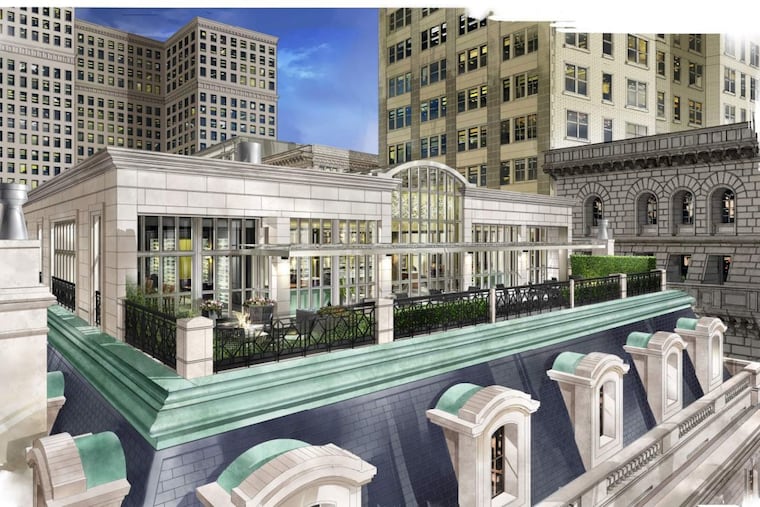Coming in 2023: A $25 million rooftop restaurant for the Union League
The skyward growth is meant to help the 160-year-old Union League remain competitive and provide a more relaxed environment, where the club’s strict dress code can be modestly eased.

People who have attempted to traverse 15th Street near the Union League in recent months will notice their progress impeded by a construction project that blocks much of the sidewalk. Fencing and heavy equipment shroud the rear of one of the city’s most venerable social clubs.
What’s afoot at this august institution? The construction is all most of us will ever see of a $25 million investment in a rooftop restaurant with an expansive terrace, coming in 2023.
The skyward growth is a sign of the 160-year-old Union League’s commitment to Center City in the pandemic era. The idea is to offer a more relaxed environment, where the club’s strict dress code can be modestly eased and give members a private place to dine outdoors downtown.
“It shows a real faith in the city,” said Lee Hyden, principal at the H. Chambers Co., and lead architect on the project. “I wouldn’t call it modernizing, but it is contemporary. Staying with the times, keeping it relevant, so that they can stay in the city.”
It also comes as the historic institution has been expanding its holdings beyond Center City, while facing new competition for the first time in recent memory from the Fitler Club at 24th and Market Streets.
The Union League did not respond to requests for comment about the project. Members are not allowed to speak to the media about club business.
“We believe that this … will allow us to respect our history as we move from being your grandfather’s club to being your granddaughter’s club of the future,” Jeff McFadden, CEO of the Union League, said at a 2021 Historical Commission meeting, when the project was given permission to move forward.
The Union League’s leadership had been contemplating an upward expansion for a couple years before the pandemic and the club decided to move forward with the rooftop dining expansion in early 2020 before the pandemic struck. The original cost was slated to be $18 million, but construction prices have spiked since. Last year McFadden told the Historical Commission that the project is being built with union labor and would add 25 permanent jobs to the club’s 450-member workforce.
Construction is expected to be completed by this time next year. It will include a 9,600-square-foot rooftop restaurant with a 1,400-square-foot outdoor terrace. It is designed to largely be invisible from the street.
The restaurant is being built atop the Union League’s annex, an addition that was constructed between 1909 and 1911 by renowned architect Horace Trumbauer and faces 15th Street.
A vestige of another era, the club feels like something out of a Henry James novel. The original red-brick Second Empire edifice at 140 S. Broad St. dates to the 1860s and was designed by architect John Fraser, who was Frank Furness’ mentor.
It was built shortly after the league’s creation to rally Philadelphians for the Northern cause in the Civil War. Back then, membership was contingent upon support for the Republican Party, a requirement that wasn’t lifted until 1975.
In addition to fiercely backing the North, the Union League supported Reconstruction and civil rights for Black residents of Philadelphia after the war. Historian Allen C. Guelzo notes that the club’s Broad Street edifice was firebombed in 1866 because of the membership’s endorsement of streetcar desegregation.
A century later, the Union League saw its social standing challenged by the flight of capital from the city, as suburban clubs undercut older urban social institutions. The club had to adapt to the changing times in other ways: The first Black member joined in 1972, and women were allowed as members in 1986 after a lawsuit was threatened. (The city’s oldest social club, the Philadelphia Club, still does not allow women to be members.)
Today, the Union League regularly wins Platinum Clubs of America’s top ranking for best historic city social club. In recent years, it has expanded its non-urban holdings, buying such restaurants as Gladwyne’s Old Guard House Inn and Stone Harbor’s Bungalow as well as golf courses throughout the region.
Current members include some of the city’s most elite residents from politically influential industries such as real estate development and big law firms. The club appeals to some younger movers and shakers, although the membership skews older. A 2018 Philadelphia magazine article put the average age at 57.
An October controversy over the awarding of the club’s highest honor to Florida Gov. Ron DeSantis highlighted the generational and political conflicts within the Union League’s membership.
The Union League also faces challenges from the Fitler Club, a newcomer looking to appeal to a crowd that doesn’t want to wear ties at dinner.
“They want the membership to continue to grow,” said Hyden, about the Union League. “The only way that happens is to keep younger people coming in, really being excited to be there, and enjoying the amenities that it offers.”
The rooftop expansion comes at a time when Center City’s emergence from the pandemic is hotly debated and ultra-luxury real estate development has cooled.
The stretch of South Broad Street where the club presents its face, also known as the Avenue of the Arts, is safer and in better shape than it was 30 years ago. The Union League’s investment is one of a number of projects that urban boosters point to in the area, along with continuing high-rise housing development and area restaurants.
“A lot of times people move out, but they’ve chosen to stay,” Hyden said. “This is a really positive development that keeps business in the city.”